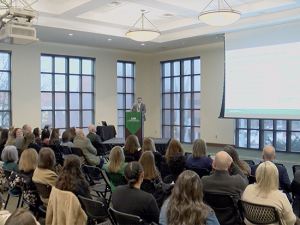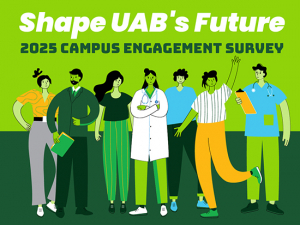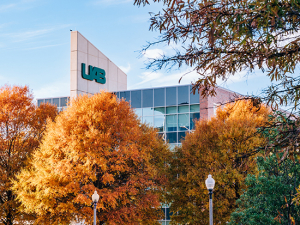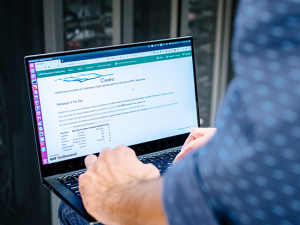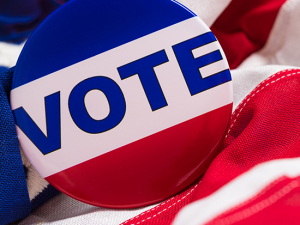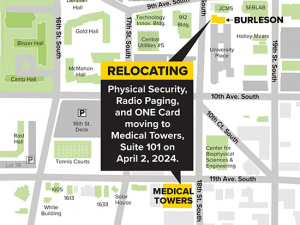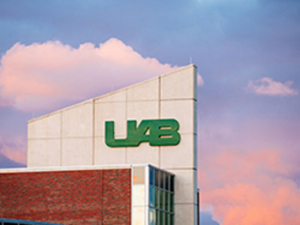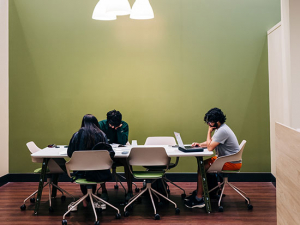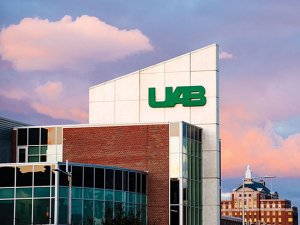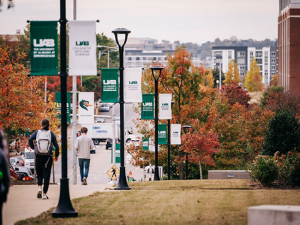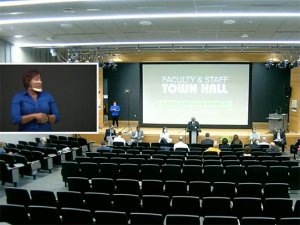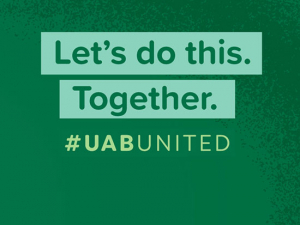Successfully bringing thousands of faculty and staff — and, eventually, students — back to campus will require a team effort and universal participation, President Ray Watts said during a virtual town hall meeting May 22.
“We want everyone back to work, and we want to be as productive as possible,” Watts said. “But we're going to keep safety and the lives of our families first and foremost.”
UAB’s gradual, phased approach to campus re-entry, announced in a campuswide email May 18 and thoroughly explained at uab.edu/reentry, includes a number of required personal safety practices and re-entry expectations.
These measures include the wearing of masks/face coverings by faculty, staff and students at all times while in public areas, social distancing, hand washing and enhanced cleaning procedures. Employees and students on campus also must complete the UAB Healthcheck COVID-19 assessment survey every three days. (The initial Healthcheck survey takes 20 seconds to complete and subsequent surveys take 10 seconds.)
“If you wish to come to campus and work, all of those are required,” Watts said. “They are in your best interest and safety… [and] it's in the interest of all of the folks working around you and the families that you come home to and people that you contact in your community…. You may say, I'm going to take my chances, if I get it, I get it. Well, that's not good enough for us as a health-promoting and -leading institution.”
The first phase of the re-entry plan started May 26, when researchers with a need to conduct their studies on campus began to return, following submission of “an operational plan that will describe how they'll keep their people safe and continue to do their work,” Vice President for Research Chris Brown said.
This phase, and the rest, will rely on vigilance from all involved, Brown emphasized. “We’re all in this together,” he said. “If someone gets sick and they are not practicing hand hygiene, for instance, others could get sick. The lab could be less productive. And it could end up shutting down that lab,” or even requiring the entire university to move back into renewed shutdowns.
In the town hall meeting, Watts, Brown, Provost Pam Benoit and other university leaders fielded questions about face masks, cleaning and many other details of the re-entry plan. Answers to those questions — and more than 70 additional questions that could not be answered live due to time constraints — are below. Click here to watch a video of the full hour-long event.
(Jump to answers in specific categories of questions below or read on for the full summary.)
Permanent work-from-home/revised work schedules
Re-entry process/timelines:
Q: How soon should we expect our managers to complete the timeline for return to campus so we know which phases we're included in?
Supervisors are working on those plans right now, Benoit said. “They will try to get them developed as quickly as possible. But I want to emphasize that the plans have to be flexible. It's possible that a plan that is approved next week or the following week has to be adjusted over the summer or fall as different events happen and we learn more about the spread of the disease.”
Q: Do you plan on furloughed employees coming back sooner than the July 31 date?
“I think the July 31 date is still the overall date,” said Allen Bolton, senior vice president for Finance and Administration. “There are segments of the furloughed population that may come back sooner as return to work plans are approved by units — and they are approved as they come through.”
The following questions on the re-entry process were submitted during the town hall but time did not permit answering during the event. The answers below have been provided by UAB leadership.
Q: For employees who are waiting to hear from their supervisors on when they can come back to work: what advice do you have on what we can do in the meantime to prepare to come back to work?
A: Review the information at uab.edu/coronavirus and uab.edu/reentry and read official emails from UAB and your eReporter faculty/staff newsletter.
Q: When you are in a group that has been approved to return to campus will you have to be tested first? And if you test positive without symptoms what is the plan that we will follow?
A: Not at this time for all employees, but some areas (e.g., clinical) do require testing. Testing protocols will evolve in future phases. Those who test positive will work with Employee Health to receive approval to re-enter campus.
Q: Can information be shared regarding how an employee approaches employee health, and what documentation they need to have?
A: If a UAB employee (faculty, staff or hospital) has been exposed to the virus, or if that employee has fever or symptoms that make them concerned that they may have the virus, they can call the UAB Employee Health Triage Line at (205) 934-3675 for guidance on whether to seek further evaluation.
Employees should call UAB Employee Health at (205) 934-3675 from 6:30 a.m.-5:00 p.m., Monday-Friday. After hours and on weekends, call the UAB Call Center at (205) 934-3411 and ask them to page the needlestick/exposure nurse on-call.
Q: Could you please tell us more about the rationale behind inviting individuals to complete their required COVID-19 Basic Safety Training, rather than posting an open link on the re-entry site? Many staff in my area are part of research teams, but didn’t receive an email.
A: This is for tracking purposes to ensure that necessary steps are taken before re-entry. Units must have an approved operational plan before employees can complete the required training, and the training must be complete before an employee completes the Healthcheck. This also helps HR verify that UAB personnel have completed their training.
Q: Are these plans the same for Health Services Foundation employees?
A: No. The details at uab.edu/reentry are for the university.
Q: In addition to the COVID-19 training that we will be required to do before we return, can we advocate for a mental health COVID-19 specific training module that we are all required to do as well so that we can best support the mental health needs of faculty, staff, and students?
A: Although HR is currently not requiring a mental health COVID-19-specific training, there are valuable resources available through the UAB Employee Assistance and Counseling Center (EACC) to meet the emotional health and well-being needs of faculty.
Please visit the EACC website to learn more about upcoming programs and events and the HR COVID-19 employee resources webpage for additional information. Just to highlight a few of the current initiatives, you will notice the Mental Health Awareness Month campaign, myStrength web-based application, Mindfulness Tuesdays and Thursdays, and their new online Mental Health First Aid Course.
Also, Kognito is now available to UAB faculty, staff and students. Kognito is an interactive platform that helps others learn how to talk about mental health concerns with a primary emphasis on suicide prevention. It only takes about 30-45 minutes to complete each module.
Story continues after box
Permanent work-from-home and revised work schedules
Q: Do you see the possibility for permanent work-from-home options for some teams?
“As we go through the phases, that's certainly something that would help us to maintain social distancing,” said Allen Bolton, senior vice president for Finance and Administration. “I would not call it permanent work-from-home but extended work-from-home as we go through different phases. We're looking at what has worked and what has not in this environment…. As painful as it has been, there are things that we've learned that we will want to apply to the new norm and whatever that looks like. We'll examine how productive and efficient we've been able to be in a remote setting and that's variable across units.”
The following questions on working from home were submitted during the town hall but time did not permit answering during the event. The answers below have been provided by UAB leadership.
Q: Can we change our work schedule such that we can minimize our workdays, like working four days at 10 hours a day, or seven days on, seven days off?
A: Alternate staffing plans are a possible option outlined at uab.edu/reentry, and these decisions will need to be made at the unit/supervisor level.
Employee child-care considerations
Q: Given that there are many UAB families where both parents work with children in high-exposure areas how can we get suitable child care in small settings? This is scary and it could severely impair parents returning to work safely without concern for their children. Is there child care on or near campus that can go beyond state regulations for day care centers?
“We've convened a task force looking exactly at that issue,” said Emily Wykle, project director in the Office of the President. The task force is developing two sets of guidance, Wykle said. The first, for working parents, can be found under the new Childcare Resources tab on HR’s COVID-19 Resources for UAB Employees page (see the heading Guidance for Working Parents after you click the Childcare Resources tab). This guidance gives employees advice about what resources are available and how to connect and talk to their supervisor about the options available, Wykle said. The other guidance, which will be provided soon, is “for supervisors managing employees with child-care responsibilities, and that lays out resources available in terms of child care as well as different options for flexibility and flexible work arrangements,” Wykle said.
In addition to guidance for working parents, the Childcare Resources section of the COVID-19 Resources for UAB Employees page includes information on:
- open home-based child-care centers and larger care centers for ages birth to 5 (under the Available Childcare Providers subhead);
- virtual programs offered through UAB (under Virtual Programs); and
- summer programs available for school-age children that are open and operating this summer (under Summer Camps).
High-risk employees
Q: A classroom with air conditioning would be a horrible place for a virus. What are some of the legal consequences for someone in the class catching the virus and a faculty member dying from the high risk?
Employees are “being given the opportunity to work with Employee Health to identify themselves in that category [of high risk],” said Selwyn Vickers, M.D., senior vice president and dean of the School of Medicine. “In the process of going through the Healthcheck we're not asking you to tell us that, but we recognize that it's a group of constituents with concerns and we want to make sure that we give opportunities to accommodate them in that setting.”
The online training that all employees will complete as they transition to campus re-entry includes “a section that asks if there's a need for a level of accommodation,” said UAB Chief Human Resources Officer Alesia Jones. “And maybe that's due to an underlying health condition. It routes you to a process for you to be assessed if there's an accommodation required or needed. As everyone is re-entering the work force on campus, we'll ask that question and give opportunities for that level of assessment.”
Q: There’s a rumor that senior faculty over age 70 will not be allowed on campus until September. Is that true?
“That's a rumor,” Watts said. “No,” Benoit added.
[In a follow-up question, an employee asked leadership to elaborate on these answers.]
A: Faculty will be required to complete training and the UAB Healthcheck after their unit-level operational plan is approved, but age will not keep someone from returning to campus. If university students, faculty or staff voluntarily express concern about returning to campus due to age or a medical condition, encourage them to contact Human Resources (faculty and staff), the AWARE Program (faculty and staff), or Disability Support Services (students). Individuals in a high-risk category may be eligible for a reasonable accommodation, leave of absence or other mitigating measures. Please note, however, that a fear of contracting COVID-19 is not recognized generally as a valid reason for an accommodation.
The following questions on high-risk employees were submitted during the town hall but time did not permit answering during the event. The answers below have been provided by UAB leadership.
Q: What is UAB going to do for those of us who are at risk with co-morbidities who do not have private offices and whose doctor has stated they need to be in an office so they can close the door?
A: We are exploring many options, and those at greater risk are being considered. Guidance for high-risk individuals — and a list of conditions that are high-risk — are posted on the uab.edu/reentry site here, and guidance and strategies will continue to evolve to address concerns as we advance in this fluid situation.
Q: How will situations be handled in which a UAB employee is called back to work, but their spouse/partner is still working from home? What if the UAB employee would like to continue to socially distance for the protection of themselves and their spouse/partner?
A: With supervisor approval, some employees will be able to remain remote for some period of time. This will vary by role and each unit’s operational plan. Additional information is available at uab.edu/reentry.
Workgroups
Q: Based on the town hall [in the School of Medicine May 21, available to view here for those with access to the ONE UAB Medicine intranet], the delineation between what is UAB and what is hospital is unclear. Can you help us understand when we follow guidelines from which entity if we straddle the lines?
“One of the things we've done to help with that — and it's not absolute all the time — but we developed the workgroups that defined and placed all of our staff into either Workgroup A, which is academic and administrative, and Workgroup C, which is clinical,” said UAB Chief Human Resources Officer Alesia Jones. “And faculty is Workgroup F…. Because the lines were blurred, the workgroups were created to provide more clarity to have you understand where your workgroup is and what processes and policies that you follow. You can find your workgroup on the website. You can log in and it tells you which workgroup you are a part of.”
The following questions on workgroups were submitted during the town hall but time did not permit answering during the event. The answers below have been provided by UAB leadership.
Q: Many Workgroup A staff work in clinical settings. What are their directions?
A: If an individual’s responsibility is not clear, they should consult with their supervisor. If there is still confusion, contact Human Resources.
Q: There are several employees classified as clinical in group C that are not clinical employees.
A: Discuss with your supervisor if there is a concern that your workgroup is not correct. If necessary, they can work with Human Resources to correct.
Q: The workgroups are there, but not the number 1, 2 or 3. How can we tell which of those categories to we fall into?
A: Individual supervisors assign employees to Group 1 (working onsite), 2 (working remotely) or 3 (unable to work onsite or remotely) during the time of limited business operations. Some employees moved within these subgroups over the past weeks. However, the Workgroups of A, C and F will not change. Check your Workgroup here and ask your supervisor for your Group 1, 2 or 3 assignment.
Research, phase 1:
Q: Can you address during which phase the employees in Research Administration would return?
“The yellow phase 1 is for faculty and staff and grad students and post-docs who need to be on campus to do their research,” Vice President for Research Chris Brown said. “Research administration by and large is something that can be done remotely…. If you can do your work remotely you need to continue to do that. If your research administration requires you to be on campus and you are a supervisor and you have an operational plan in place and you've done the Healthcheck and training, you can come back in. We don't anticipate a lot of research administration on campus in the first phase.”
The following questions on research were submitted during the town hall but time did not permit answering during the event. The answers below have been provided by UAB leadership.
Q: For research that relies on UAB core facilities (CRU, CINL), will each of those facilities develop guidelines for resumption that can be integrated into a PI's return to operation plans?
A: All Institutional Research Cores have developed operational plans. All school and departmental cores have or will develop operational plans that can be integrated into PI plans. Contact the core director for their approved plan.
Q: Are we allowed to conduct in-person follow-up visits with research participants? if so, who will pay for PPE? Grant account or UAB?
A: Yes, as long as the guidelines set out in the Resumption of Human Subjects Research are followed. PPE is the responsibility of the individual unit.
Q: When will we be able to hire necessary personnel for research projects? Currently the hiring restrictions are keeping many laboratories that are doing essential research unable to meet the milestones necessary to move their research along.
A: Visit the UAB Temporary Hiring Suspension Exception Process documentation to make a request. These must be approved by the dean and appropriate vice president.
Q: Will Institutional Core Facilities be allowed to re-open May 26?
A: Yes, if they have an approved operational plan.
Q: Currently we are being asked to hold off submitting things that are not COVID-related to many research administration offices — when will operations return to "normal"?
A: You may begin submitting non-COVID items starting May 26.
Q - One of the statements on the r2ops human subjects research page states that if the participant’s physician chooses not to proceed with COVID-19 testing, then it is the PI's responsibility to ensure the COVID-19 testing is conducted prior to re-engaging the participant in future screenings. Will kits be available for the PI to test or certain permissions to request such testing on behalf of the participant?
A: If a potential research participant screens positive for COVID-19, RNA testing needs to be conducted with a PI-verified negative result prior to re-screening the participant. The UAB R2Ops Human Subjects Research Task Force is currently developing a path to facilitate RNA testing that could be used by the participant’s primary care physician or independently by the participant.
Masks
“We will ask people to wear masks,” said Selwyn Vickers, M.D., senior vice president and dean of the School of Medicine, in his opening remarks. “We understand that you may be feeling fine and it may be cumbersome, but the masks do two things. There's a significant number of people that carry the virus and have no symptoms and the mask prevents the spread, because the spread comes from… the mouth. The mask keeps you from putting your hands on your face as well.”
Q: If an employee works in a private office, can they work without a mask and wear a mask when they leave their office?
This question is answered on the uab.edu/reentry site, Benoit noted. “The recommendation is if you are in a private office and no one is coming in or out, you do not have to wear the mask in that office. But in common areas and entering the building, that's when you should have the mask on.”
Q: Is there going to be enforcement [of the mask policy] and how will it be enforced?
“It's the responsibility of the supervisor to be sure that their employees abide by these requirements,” Watts said. “If they don't, [the employee] may well be sent home. And if you want to work on our campus, it's going to be required that you follow the safety guidelines.”
The following questions on masks were submitted during the town hall but time did not permit answering during the event. The answers below have been provided by UAB leadership.
Q: Regarding face masks/coverings: Is there a reason why UAB police are not wearing masks even when they're interacting with other officers or public without masks?
A: UAB Police officers do wear masks when in public and interacting with members of the community or other officers. During limited times at which it is necessary for an officer to remove his or her mask — for example, when taking a water break — the officer will maintain a safe distance from others.
Q: Who should university departments and units contact regarding PPE?
A: Procurement-related questions for UAB non-hospital purchases will be addressed by University Purchasing; contact information and procedures for procurement of PPE can be found here.
Q: What about students wearing masks? Will it be mandatory for them to wear them?
A: Yes.
COVID-19 Testing
Q: During the last town hall, Dr. Vickers mentioned the availability of antibody testing and sentinel testing. Where are we on those tests?
“We don't have clarity on the role of the antibody test,” said Selwyn Vickers, M.D., senior vice president and dean of the School of Medicine. “We can test you to see if you've been exposed and you have antibodies. We can't guarantee that that means immunity. But if you look at large cities with the most prevalence of the virus and the community has been tested, no more than 10% to 12% have been positive.” Looking at even larger areas, the positive rate has been anywhere from 2% to 5%, Vickers said. “There's not a lot to do with the data. You have 90 percent of the constituency that still doesn't express the antibody and you have to have a plan for them. When you get to 65 percent you are approaching herd immunity.
“So we would like to have a baseline measurement of antibody testing to know what the sample looks like and then again at a later period in the summer. We can do about a thousand a day [antibody tests at UAB Hospital] and if we grow that we want to do it with some population within the community and then retest the population to create a level of exposure that makes a difference.”
Q: Will families of UAB faculty and staff be eligible for testing?
“There’s significant capacity in the Jefferson County area [now] to get tested,” Vickers said. “And so I think that's available for individuals who choose to do so through the multiple test sites. You can go through the Jefferson County Department of Health website to show you where you can get tested.”
The following questions on COVID-19 testing were submitted during the town hall but time did not permit answering during the event. The answers below have been provided by UAB leadership.
Q: If a student tests positive, how will the university ensure that the student does not come to class?
A: Students will be required to verify their status using the Healthcheck, and Student Health will need to approve re-entry for a student who has tested positive.
Q: Are there still problems of false negatives/positives with COVID-19 testing?
A: This depends on the test. The tests conducted at UAB are extremely sensitive and reliable.
Q: What about people who may be asymptomatic?
A: The vast majority of COVID-19-positive individuals will have symptoms at some point (the a-symptomatic are often pre-symptomatic). Symptom and exposure tracking and contact tracing technologies will be used in conjunction with other strategies to help identify potential issues.
Q: If someone working on the campus is found to be COVID-positive, which actions will be taken?
A: The individual who tested positive will work with Employee Health for guidance and eventual clearance to re-enter campus. Individuals determined to have been at risk of exposure will receive notice and appropriate guidance. Environmental Services will conduct appropriate cleaning and disinfecting.
Q: Random COVID testing was mentioned. Does this mean employees could be randomly tested by nasal swab or by other means?
A: At this time, we will use nasopharyngeal tests, but this may evolve as different testing options (e.g., saliva tests) become available and are deemed reliable. [See this section of the uab.edu/reentry site for more on random testing.]
Healthcheck app
Q: How often will people have to complete the symptom tracker and when is it available and is it required for research resumption?
“The Healthcheck app is fundamental to gathering information about what activities are going on both at a school, a unit and an institutional level,” said Selwyn Vickers, M.D., senior vice president and dean of the School of Medicine. “The data coming back from that is important to go to Employee Health, to Student Health and to a group of leaders who will be looking at an incident command team to make sure we can act on data when we see it. So, yes, you'll be asked to do that when you've gone through the LMS learning module.
“The second piece is that the average incubation of the virus — not the symptoms — is about four to five days. So, every three days you are asked to respond to a text that you get. We would ask you daily if you have a symptom or a change in symptoms to respond… But we will inquire and ask that you document a response every three days.”
| See more FAQs on UAB Healthcheck on the uab.edu/reentry site. |
“This application is very simple,” Watts added. “If you are prompted, it will say, ‘How do you feel today?’ If you are good, well, and healthy, you say that and nothing else, done. If you say, ‘I’m not feeling well, I feel sick.’ Then you go into a series of questions that give information indicative of CDC guidelines for the diagnosis of potential COVID infections, like fever, could have, chest pains, et cetera. If those are positive, it gives you the next decision points about contacting Employee Health, or Student Health, and what to do, but to not come back to work if you have symptoms until you are totally checked out.
“And let me make it clear. It's not optional. This is required. To come back to work on campus, you have to take the new training module that teaches you about Healthcheck and it teaches you about the proper safeguards: social distancing, hand washing and face masks. Then when you have all of this in place, you are ready to go back to work.”
Q: Will using the Healthcheck on the UAB app be the correct app to use as an employee, because the website says the Healthcheck is not the same as the HelpBeatCovid19 app?
“That is correct,” said Rosie O’Beirne, interim associate vice president for Digital Strategy and Marketing, who has been involved in the development of both apps. The team that put together the UAB Healthcheck app “tailored that product for UAB re-entry,” she said. “And just a reminder to everyone, because we are phasing in, if you do not get a prompt from the LMS to take the training, you do not need to do the Healthcheck now, until you get further information. Right now we're trying to focus on the research community. If you don't get the prompt, you don't do the Healthcheck currently.”
Q: There are questions in the community about how HIPAA applies to the tracers with Apple/Google. Are those who are tested entered into the tracer? [This question refers to a separate proximity/contact tracing app, being developed by UAB in conjunction with the Alabama Department of Public Health, that individuals can use to report a positive test result and anonymously notify other individuals who have come into close contact with them that they may have been exposed to the virus.]
“The tracer application has all of the data associated encrypted within the operating system itself and we can access pieces of that,” said Curt Carver, vice president and Chief Information Officer for UAB. “The only thing we’re reporting to the individual is the date that something occurred, a possible risk exposure. We're not capturing or sharing other data. We actually can't get to it within the operating system. The reason that UAB is partnering with the Department of Public Health and with Apple and Google is they are putting the greatest protections on your privacy and security into the app.”
“The data of a positive test is going to the state Department of Public Health that verifies that” for the contact tracing app, Vickers said. Whereas with the UAB Healthcheck, “you have to voluntarily put in that you tested positive — it's not information that we're taking.”
With the contact tracing app, “if you are notified that you've been in contact, it doesn't tell you who tested positive,” Benoit said. “That's anonymous. It just says that you've been in contact for more than 15 minutes with somebody and you need to take certain action steps.”
“That’s very true,” Vickers said. “The actual capacity of it is pretty smart. It looks at attenuation, whether you are in contact with someone through a plexiglass wall or a regular wall. It's smart with the time period and distance and it gives a risk score that we helped design. It makes it realistic and relevant. So, when you get it, if you want to document your symptoms or quarantine or get tested could be relevant and very powerful.”
The following questions on the Healthcheck and contact tracing apps were submitted during the town hall but time did not permit answering during the event. The answers below have been provided by UAB leadership.
Q: Do we know how well people are aware of the contact tracing software?
A: The contact tracing software has not yet launched. When it is it will be communicated broadly.
Q: I am having trouble logging into Healthcheck after having completed the training course. Are there some issues going on that are causing this problem?
A: There is currently a nationwide issue with Qualtrics (the tool underlying the Healthcheck system) that has affected some users. If you continue to have trouble, you can send questions to healthcheck@uab.edu.
Q: Is the Healthcheck reliably texting users every 3 days? I ask because I completed it but was never texted again. I wonder how many others have experienced the same?
A: You have used the public symptom tracker at helpbeatcovid19.org. The UAB-specific Healthcheck symptom tracker will require Blazer ID login, and your required participation will be monitored. If there were to be a problem in complying, you will be notified, and any problems with reminders can be addressed.
Q: Will there actually be a "UAB Healthcheck" app, or is it really just a texting service?
A: This is a web-based platform that uses texting for reminders.
Q: How does the Healthcheck help with managing individuals that are asymptomatic?
A: This tool is used in conjunction with other strategies and not alone. It can help identify potential issues among groups, so while an individual in a group may be asymptomatic, others in the group may show symptoms and help identify a potential problem area that can be more quickly addressed with this tool. The vast majority of COVID-19-positive individuals will have symptoms at some point (the “asymptomatic” are often pre-symptomatic).
Q: If we are not cleared to come back to work based on the Healthcheck can we work remotely from home or will we be required to take sick time?
A: With supervisor approval, some employees will be able to continue working remotely for some period of time. If you are required by Employee Health to self-isolate for a period of time, that will be with pay.
Q: I'm a cellphone troglodyte who has a flip phone that is rarely turned on. Will I need to get a more modern phone to be able to work on campus?
A: No. You can access the required Healthcheck via a computer web browser. You will not be able to use the contact tracing app, which requires a smartphone, but that technology — while strongly recommended — will be voluntary.
Q: Is there a Healthcheck process for employees that have to come to campus for essential business but are not officially in the group to return?
A: No, not at this time.
Q: Do non-UAB employees receive notification of contact with a COVID-positive individual, if they do not have the tracing app in their phones?
A: The contact tracing app is one way to receive notification. The Alabama Department of Public Health may also contact potentially exposed individuals. The contact tracing app will be available to non-UAB individuals as well, so they could potentially be notified by the app or through official public health channels.
Q: Is the tracker meant for snitching on your fellow employees?
A: No. The contact tracing app was designed by Apple and Google to protect personal information. The notifications simply alert an individual that they are at risk based on the time and proximity they were to someone who tested positive. Individuals, time and place are not identified in notifications.
Workplace cleaning and safety
Q: How are units going to get access to hand sanitizer and face masks and disinfectants? Purchasing outside the hospital has been difficult and a drain on our budgets.
“We're asking that you work with procurement to acquire the materials,” said Allen Bolton, senior vice president for Finance and Administration. “The underlying message is that supply chains are tight for certain things, we know that, so the sooner your units can develop a plan and turn in the requested PPE or sanitizing materials to University Purchasing, the sooner we can queue that up for you to get materials in a timely way. We have a decent supply of masks and gloves for the gradual re-entry right now. We have a pinch point with the sanitizing wipes but we're getting some access to those, and there will be alternative methods for cleaning that will be pushed out and recommended by the great Facilities crew.”
| Download approved, print-ready signage for stairs, elevators and other building common areas from uab.edu/reentry. |
Q: The New York Times said that stagnant plumbing systems can put employees at risk for Legionnaire’s disease and other illnesses. What is UAB doing about that?
“Our maintenance and facilities crews have cleaning guidelines they are following based on the guidance of the CDC,” Bolton said. “The buildings will be safe for return.”
Q: Will the entrance of every building have sanitizer and can you comment on housekeeping standards? Stairs will be used more and in the past, they were not cleaned frequently.
| Read the full UAB Facilities Re-entry Guidelines, including enhanced cleaning and disinfection protocols and schedules/details of cleaning in labs, stairwalls, private offices, clinics and more on the uab.edu/reentry site. |
“There's new heightened sanitation standards,” Bolton said. “First of all it relates to disinfectants approved by the CDC and we've ordered those in quantities and there's much more frequent wiping down of surfaces that come into contact like handles on doors and stairwells,” Bolton said. “And we'll encourage social distancing in elevators. Particularly if it's a couple of flights, we'll highlight the use of stairwells and they'll be cleaned to a higher standard than pre-COVID.”
The following questions on workplace cleaning were submitted during the town hall but time did not permit answering during the event. The answers below have been provided by UAB leadership.
Q: Is there any discussion of using any type of new technologies/methods for sanitation, such as UV light?
A: UAB has invested in equipment to sanitize large areas using a misting disinfection machine. We are taking guidance from the CDC and our experts on campus for best practices regarding sanitization. At this time, UV light does not work for our needs.
Q: I have seen re-entry guidance on elevator usage, but what about stairwells that 100s of people use every day many times, utilizing the handrails and exit doors?
A: Stairwell handrails and door hardware are included in the touch points that are being cleaned continually as part of our enhanced cleaning practices. Recommendations have also been made to designate stairways as up or down if multiple stairways are available in a building to reduce contact. Occupants wearing masks and practicing hand hygiene will also reduce contamination in the stairwells.
[The following three questions cover similar topics and are answered together below.]
Q: Are we upgrading the filtering systems of our buildings to provide the best recirculated air possible?
Q: Some research has reported that it may be possible that the virus might be able to be transmitted through air conditioning systems. There is a lot of research going on in Canada about this. Has UAB thought about this possible method of transmission?
Q: Has the committee viewed office areas where there is no proper air ventilation for staff? It has been stated that germs grow in non-ventilated areas.
A: The filtering used in our HVAC systems are already the highest quality that can be utilized. We are closely monitoring the most recent data and adapting our operations, based on the current guidance available (CDC; American Society of Heating, Refrigerating and Air-Conditioning Engineers; etc.).
If new information regarding these systems is provided through the CDC, we will address it quickly.
If you have a specific area of concern, please contact Environmental Health and Safety.
Q: Have there been any discussions of pre-sanitizing office spaces, classrooms and clinical areas from a professional group prior to re-entry?
A: Classrooms and clinical spaces have been or are being disinfected prior to re-entry. Unused office spaces have no need to be disinfected as the virus cannot live on a surface outside the host for long periods of time.
Q: Given furloughs of Environmental Services personnel, how will enhanced sanitation be undertaken in buildings?
A: Furloughs can be ended early, if necessary, to address areas of need as functions on campus resume. The building locations of each person scheduled to return to campus are being collected to assist Building Services in preparation.
Q: Will classrooms be sanitized between classes?
A: Details of the return-to-instruction plan are still being developed. It’s important to understand that individuals have the responsibility to wear masks and practice hand hygiene to reduce contamination in all areas.
Q: Can you address parking and the shuttle service? The shuttles are historically very crowded; how will social distancing be accomplished?
A: Blazer Express has initiated safety protocols including limiting the number of riders and requiring masks in addition to enhanced cleaning and sanitizing.
Q: Will the parking deck levels be rearranged to assist with social distancing? For example, if you work on the first floor could you have designated parking on the lower level to prevent that staff member from having to use the elevator or the stairs on other floors?
A: We do not have plans to reorganize parking at this time. It’s important to understand that individuals have the responsibility to social distance, wear masks and practice hand hygiene to reduce contamination in all areas.
Q: What is being done to coordinate cleaning in buildings where UAB divisions work that aren't UAB-owned?
A: We’re working with the owners of all non-UAB buildings to ensure our cleaning practices align.
Fall semester schedule
Q: Are there discussions or plans to start the fall semester early and end it before Thanksgiving, similar to what other universities have decided?
“There are 15 different scenarios out there about ways universities might start,” Provost Pam Benoit said. “One of the difficulties with starting early is we have to get ready early…. We're looking at Thanksgiving in different ways. There was talk of moving back a week, but it was not a decision at that point in time, it was a model we were considering. We're in the process of working on that.”
“We're talking about many different kinds of scenarios about when to start,” said Lori McMahon, Ph.D., dean of the Graduate School and chair of the subcommittee working on scheduling of fall semester classes. “We're watching what other institutions are doing and seeing what will work best for us. We're working hard and trying to come to conclusions soon, and you'll be aware of those decisions as soon as the provost is aware and others.”
While there are many different scenarios possible, “there's very little data or any data to validate the scenarios,” Watts noted. “The biggest concern with Thanksgiving is not about a potential resurgence of the virus, it's about all of our students and employees going home, particularly the students, and then coming back. That's something that we have to work around and work through, but we'll be making decisions and plans and we'll have alternative plans because it's going to be a fluid situation. And I reiterate to you right now the virus is not gone away. Cases in Alabama are still going up. Over the last week or so there's a 19 or 20 percent increase in the state. So we'll come up with the best plan and safeguards and testing capacity that we can. But it's going to evolve over the coming weeks.”
Q: What does all this mean in terms of planning for classes in the fall?
“You should plan to enrich your Canvas websites to be able to offer your classes online and in a face-to-face, in-person situation,” Benoit said. “We need the most flexibility throughout the semester. Think of how you can offer your materials in an online, remote kind of format.”
Q: Can UAB make its own decisions about fall semester and classes or is one decision being made for all UA System campuses?
Decisions to return to campus depend “on the specific plans on the three campuses,” Watts said. “Where we can aid the other campuses in planning, because we have the most medical and public health expertise, we want to do so. But each of the three campuses are different and the constituents or the members of those campuses are different. And we'll work with the UA System leadership, the other campus leadership, the board of trustees, to put together the very best plans that meet the needs of UAB, and we'll help the sister campuses to be as safe and productive as possible, too.”
Q: Have any plans been made yet regarding UAB athletics?
“What we're planning right now, in the broadest sense, is as the students return to campus in the fall, the student athletes will return to campus,” Watts said. “Depending on the prevalence of the spread of the virus we'll make the best recommendation we can coming into the fall semester. Right now as we've discussed practices, etc., we don't believe it's safe for our student athletes to have contact sports and be together right now. We don't know enough about it or how to protect them well enough.”
Watts continued: “You may have heard that the NCAA made a statement about how they are going to allow the return of football and men’s and women’s basketball this coming academic year. They don't have any data upon which to have that strong of an affirmation. We're going to plan for that ourselves, but we're going to plan first and foremost for the safety and the protection of the lives of our student athletes and the athletics department and so forth. We'll make careful planning and it's going to be guided by data and medical and public health information and for how we think we might be able to bring those teams together.”
Q: Some universities and colleges have already dispersed CARES Act money to their students. Where is UAB in the process?
“We've sent emails to students that are eligible,” Provost Pam Benoit said. “Within two days of those emails going out we've had over a thousand students filling out the applications and we plan to distribute the funds starting on June 2.”
Q: When will we know when students can move into dorms?
“If you look at the number of students that requested to live in the residence halls by making a deposit and signing a contract in early spring, the demand to live on campus was much greater than capacity,” said John Jones, Ph.D., vice president for Student Affairs. “And given the last 90 days or so, we're still seeing that the demand is greater than available space. We anticipate them moving in. What is to be decided is the number of students living on campus. We're looking at full capacity and half capacity and something in between. We're working with campus leadership and the transition task force, Allen [Bolton] and Pam [Benoit]. Certainly the decision will be made in the near future.”
Very few institutions “have declared exactly what they'll do in the fall yet,” Benoit noted. “So we're not behind where other places are.”
“Our newest buildings have two students per room in fairly close proximity,” Watts said. “And we'll have to assess how all of this is evolving and it could be that we would only allow one student in a room. And if there are larger suites with bedrooms and so forth, there would have to be an adequate plan for safety for us to let that occur. We’re monitoring that very closely, and it's a fluid situation.
“We expect to have students living in our residence halls this fall, but we don't know the density or how it's going to be organized,” Watts said. “We're going to use data for further faculty and staff return and resumption of student activities. We're equipping our instructional classrooms to allow us to do video conferencing or in-class teaching at the same time. We want to make it as flexible as possible. And we don't have a crystal ball.”
Q: How far off are we from sharing re-entry plans to students? They are creating their own narrative about what to do using inaccurate information and making decisions based on that.
“We actually have a draft of communication to all students that's routing for approval now,” said Jim Bakken, interim Chief Communications Officer. “We should have an update to students early next week.” [The email was sent on May 27 and can be read here.]
The following questions on the fall semester were submitted during the town hall but time did not permit answering during the event. The answers below have been provided by UAB leadership.
Q: According to the ADPH, there have been zero deaths in Alabama in the age group 1-24. What is the rationale for determining that athletics is not safe, when all of those participants are in that same age group?
A: Many people involved in an athletic program are not 1-24 years old (e.g., coaches), and athletes who gather may come in contact with others. Experts are working to assess the many variables and initiate a plan that mitigates risk as much as possible.
Q: Why is UAB requiring students to fill out a request for the CARES funds when some schools are not?
A: Completion of the request form is necessary to determine (1) if a student has been financially impacted by COVID-19 and if so, the level of impact as well as (2) to establish certification eligibility as the U.S. Department of Education does not allow for these funds to be used for international students and DACA students.
Q: If dorms are filled to half capacity, how will that affect enrollment?
A: A plan for residence hall use is still under development.
Q: Will the email to students [mentioned above] include updating freshmen and first-year graduate students as well?
A: Registered incoming students do receive mass communications sent to students.
Q: At the May Faculty Senate meeting we were told to expect a delayed start to the fall semester, likely after Labor Day. The next day the final exam schedule for the fall semester was published. Are we to understand that the last day of classes will remain unchanged regardless of when we start? Should we plan for a 13-week semester, for example, as we prepare our fall courses?
A: This is a fluid and dynamic situation, and many options are being considered. Leadership and task forces are evaluating options at this time. These decisions are still being made.
Q: If face-to-face classes are to be conducted this fall, will administrators be asked to schedule themselves to teach face to face as a show of support with regular faculty and staff?
A: We are exploring many options for instructions at this time. When furloughs (university) and pay cuts (UAB Medicine) were instituted, leadership self-imposed a significant pay cut and plans to continue to lead by example.
Expense reduction questions
The following questions on expense reduction measures were submitted during the town hall but time did not permit answering during the event. The answers below have been provided by UAB leadership.
Q: Although I understand the why behind the pay cut due to COVID, I was most displeased with the decision to announce it on day one of Nurses Week. I understand it has been said a lot of thought went into the decision to announce it on that day and that it was unavoidable. However, I find it difficult to believe delaying that decision by one week or even announcing it three days earlier would have made a major difference. It was like a slap in the face to the nursing profession. Otherwise, I am proud of UAB.
A: We are grateful for our UAB nurses and the work they do, and our announcement in no way diminishes our pride in their work. There were multiple factors involved in the timing of the announcement and transparency and sharing information in a timely manner had to remain as priorities. Health System expense reductions were not final until approved by the Health System Board on the Friday prior to the Monday announcement; communications could not be finalized that same day (the three days prior referenced in this question). Also, announcing on a Friday immediately before a weekend would have made it more difficult for affected employees to access resources and get questions answered. Delaying the communication a week would have resulted in the announcement happening after the effective date of the pay cuts.
Q: In several town halls and communications, it has been mentioned that merit raises would most likely not be occurring for staff, but budget models would include plans for faculty promotion and tenure salary increases and for salary increases related to grants. How do we respond to colleagues the perceived messaging that there are have/have nots or a hierarchy of valued employees, particularly in very difficult financial times?
A: Given budget constraints, annual merit raises are unlikely next fiscal year for staff and faculty. We are planning for the standard promotion increases for faculty. Faculty participate in a highly structured process of advancement that is defined by policy and driven by factors including years of service, publications, grant funding and other productivity measures. Leadership believes that it is important to maintain this schedule. Grant-funded salaries are an indication of the source of the funding rather than a comparative value.
Q: Are there plans to furlough any additional employees at this time?
A: No.
Q: Can a hospital employee with less than one year to retirement be offered early retirement?
A: Early retirement is not an option at this time.
Q: Can we get a rebate for unused parking garage access?
A: No.
Q: Are there any plans to reduce employee tuition benefits?
A: No.
Other questions
The following questions were submitted during the town hall but time did not permit answering during the event. The answers below have been provided by UAB leadership.
Q: Is there a target date for allowing public performances in the Alys Stephens Center?
A: All units, including the Alys Stephens Center, will work on an operational plan for re-entry.
Q: Will employees exposed to COVID-19 who need to quarantine be required to use sick leave/vacation time?
A: If it is determined by Employee Health that someone needs to self-isolate, that time will be with pay.
Q: Has UAB already reviewed or planning to review the UAB VIVA health insurance regarding COVID-19 treatment (not testing) cost? Can anyone briefly talk about treatment cost and its coverage?
A: The impact of COVID-19 is currently being reviewed with both Viva Health and Blue Cross Blue Shield. Specific questions about coverage should be addressed by the UAB Benefits Office.
Q: Can we take hydrochloroquine as a preventative?
A: This is a decision that should be between an individual and their physician. Contact your health care provider.
Q: We understand Lucy’s coffee shop had to close. Is it known if Subway will be open? What about the wings place and the Mexican place? Just wondering what food options there will be at the biomedical end of campus.
A: We do not know and cannot speak to what private businesses will do.
